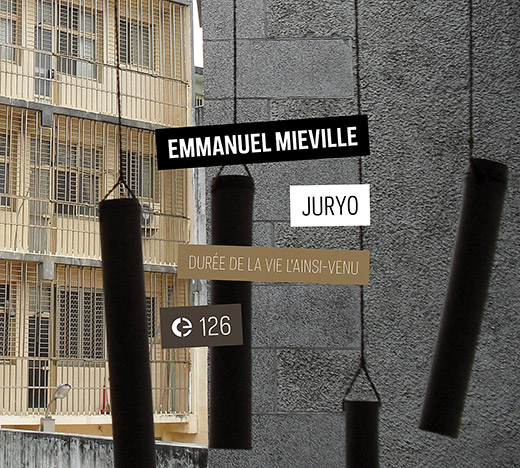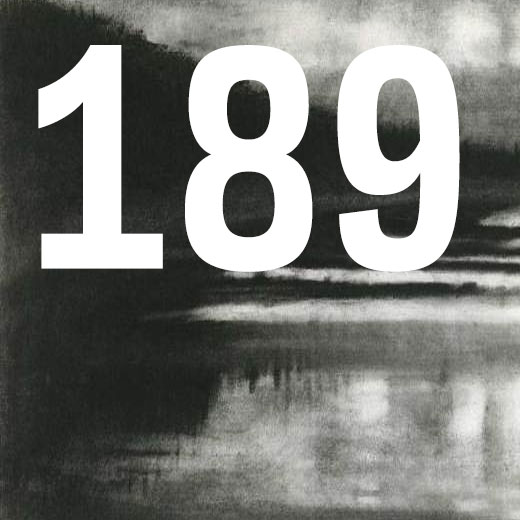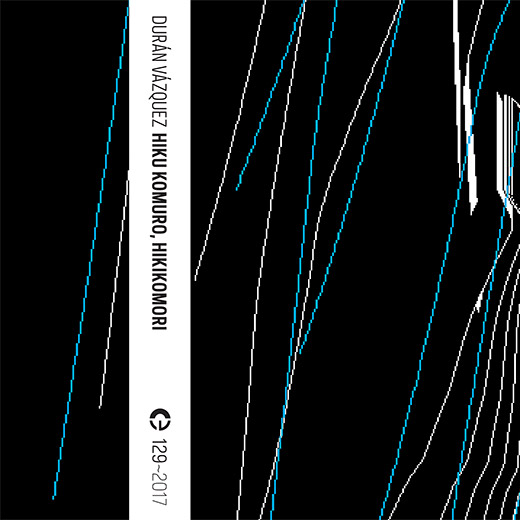“The Waste Land†reviewed by Exclaim!

There are times when the creative process is enriched by limitations. The challenge to produce meaningful work within the confines of this or that restriction can be inspiring; under certain circumstances, it can even define the work.
A fine example of this is Luca Forcucci’s The Waste Land, in which the internationally recognized artist and researcher takes a six-minute field recording from a documentary film he’s never seen and turns it into a 37-minute soundtrack. Forcucci’s WordPress site attributes the project to his interest in “perception, subjectivity and consciousness,” and lists the great avant-garde composer and musician Pauline Oliveros as a key inspiration.
Fans of her work will feel right at home in Forcucci’s new soundscape. Beautifully recorded (and mastered by Taylor Deupree), these three pieces reflect a mature, refined artistic voice that’s been recording since 2000.
The cassette’s title track launches into a white noise/heavy industry combo right from the start, followed by a delicious electronic hum. There’s no aggression here, though; the sounds are passive, sort of half-lazy. It’s just another day at the office, even if you can’t fathom what kind of hellish workplace this piece invites you to inhabit. “Voices from the Coal Mine” has a similar feel, as banging metal overpowers non-descript PA announcements, making for the album’s harshest work. Counter-intuitively, “My Extra Personal Space” takes the listener outside, and treats us to church bells, birdsong and running water. It’s a lovely contrast to the oppressiveness of the previous two tracks.
If there’s a complaint to be lodged, it’s that the work lacks an obvious musicality. But then, that’s hardly the point. The Waste Land is a success, despite — or perhaps as a result of — how little the artist had to begin with. Kevin Press
via Exclaim
Futurónica 190

Episode 190 of Futurónica, a broadcast in Rádio Manobras (91.5 MHz in Porto, 18h30) and Rádio Zero (21h GMT, repeating on Tuesday at 01h) airs tomorrow, April 14th.
The playlist of Futurónica 190 is:
- Durán Vázquez, Solus Ipse (2017, Hiku Komuro, Hikikomori, Crónica)
- Durán Vázquez, Solus Ipse (2017, Hiku Komuro, Hikikomori, Crónica)
- Durán Vázquez, Solus Ipse (2017, Hiku Komuro, Hikikomori, Crónica)
- Durán Vázquez, Koroshiya (2017, Hiku Komuro, Hikikomori, Crónica)
- Durán Vázquez, Solus Ipse (2017, Hiku Komuro, Hikikomori, Crónica)
- Durán Vázquez, Segunda Natureza (trebón, paxaros, electrostática) (2017, Hiku Komuro, Hikikomori, Crónica)
- Durán Vázquez, Earthquake Synthesizer Remix (2010, Audible Landscapes, Crónica)
You can follow Rádio Zero’s broadcasts at radiozero.pt/ouvir and Rádio Manobras at radiomanobras.pt.
“The Waste Land†reviewed by The Swatch Art Peace Hotel

Former artist-in-residence at the Swatch Art Peace Hotel has just released his new album “The Waste Land”.
The starting point for The Waste Land was an invitation to compose a twenty minutes soundtrack for a documentary movie. Accordingly, Luca Forcucci received six minutes of a field recording, without any mention of its own nature, or any information about the documentary. Forcucci didn’t ask anything about it, instead he listened carefully to the sonic material until images started to appear. The more he listened the more clear images emerged from his own mental movie.
The resonances emerge from the multiple projections of sounds into the power plant of an abandoned coal mine within a process that progressively recombines sound.
Voices from the Coal Mine is freely inspired by Alvin Lucier’s I Am Sitting in a Room. Real spaces act as resonant filters and lead to virtual spaces made of resonances. Metaphorically, it encapsulates the memory of the voices and activity of the former workers from the coal mine.
My Extra Personal Space explores convergences of timbres from antagonist soundscapes of nature from the Normandy coast and urban contexts from Paris. Soundwalking is a component and tool to investigate, listen to and compose with the environment. This piece pays a tribute to urban drift of the Baudelairean flâneur — the casual wanderer, reporter and observer in the city.
“Juryo: Durée de la vie de l’ainsi-venu†reviewed by Bad Alchemy

Badet man da in Mondlicht? Strudelt man da im Ocean of Sound? Der GRM-studierte Pariser taucht einen in eine metalloide Liquidität, die er, angeregt durch Artauds “Héliogabaleâ€, ‘Tanit Asterté’ nannte. Es ist das ein initiierendes Eintauchen, dem ein fernöstlicher Triptychon folgt: ‘Nyorai’ (eine des Inkarnationen Buddhas) – ‘Musaraki’ (japanisch für Purpur) – ‘Taisi Funeral’ (Taisi heißt Botschafter, Gesandter). Der geprägt wird von singenden tibetanischen Nonnen, Klosterglöckchen und Radiostimmen aus Hongkong, von Japansounds und Butohtänzern und zuletzt buddhistischem Trauergesang von Frauen in einem Dorf in Taiwan, der mit klackendem Beat immer mehr beschleunigt und dem Toten wohl Beine ins Jenseits macht. All das als Nudeln und Gemüse in einer nach konkretem Usus gekochten Suppe, die einen mit jedem Löffel asiatische Essenz schlürfen lässt, als Souvenirs mit Yogawikiakzent, verweht und verwischt wie von Wind und Regen, verdünnt und verschiffen in einem Frequenzbereich der Erinnerungen und der Projektionen. Mit geisterhaften Anmutungen von Gesängen, verbittert, bebend, zuckend, wie unter Wasser gehört, brodelnde, sausende, ondulierte Feldaufnahmen, turbulent verwilbelt, verdichtet und ausgepresst als der poetische Saft einer Blutente. ‘Taisi Funeral’ bekommt sogar einen dröhnenden Death Metal-Drive. Zum eponymosen ‘Nyoirai Juryo Hon’-Kapitel der “Lotus Sutraâ€, das die äugen öffnet, käme das als “Effata†der Ohren hinzu.
“The Waste Land†reviewed by Chain DLK

The title track of “The Waste Land†is an unusual example of soundwalking- strolling about gathering atmospheric found sounds and ambiences. While the process often leads to broad and relaxing soundscapes, this is a willful inversion, heavily processed, twisted and alienating. Strong gusty winds and heavy industrial noises of unknown origins lead to a scene that’s almost post-apocalyptic in its atmosphere. At times it sounds insular, almost claustrophobic, with noises akin to deep breathing noises recorded from underneath a coat. Over the fifteen minutes of the title track the sounds evolve fairly rapidly- at points there’s just a single layer, then before too long there are four or five competing noises.
“Voices From The Coal Mine†is an exploration of reverberation in a gigantic enclosed space- sporadic metal hits and scrapes fade into the distance with incredibly long echo tails which begin to layer and form their own, wall-and-material-born hum.
“My Extra Personal Space†is initially a slightly more typical and familar soundwalk- village sounds of gates, passing cars, church bells and birdsong- but as it progresses, further metallic hums and tubular resonance begins to cut through, as though something very sinister is afoot in the previously peaceful town. It all gets a bit “Village Of The Damned†in soundscape form. As it evolves further we move from Normandy to Paris, with more urban noises, metro announcements and suchlike, as though we’ve travelled more in time than in space.
“The Waste Land†is an unusual hybrid of found sounds and treatments, infused with a lot of energy. It covers a lot of ground in 37 minutes and is certainly an interesting, if not always comfortable, journey. Stuart Bruce
via Chain DLK
“The Waste Land†reviewed by Words & Guitars

An intriguing download and limited edition cassette release from a new Portuguese label Crónica, documenting the work of researcher and artist Luca Forcucci. Forcucci’s website cites his intellectual debt to Pauline Oliveros’ concept of ‘deep listening’: the ability to appreciate and perceive an environment then offer a sonic (or other) response. The results in this case are a testament to what can be wrought from this approach and will jolt the heart of anyone who appreciates dark ambient, Ben Frost’s more raw output, industrial’s less beat-driven sonic explorers, or horror soundtracks.
There are three decisively different experiences here. The title track is a glowering abyss in which metal shears, shimmers and tingles while more granular sensations split the surrounding vacuum. There’s not necessarily a visible progression, it’s more an evolving storyline rather than a cyclical experience. It developed from Forcucci being provided with an anonymous six minute sound recording and an invitation to create a soundtrack to an (unnamed) documentary. Whatever those original pieces consisted of, Forcucci’s response sounds akin to being on the launch pad under a NASA rocket: a cascade of sparking violence.
‘Voices From The Coal Mine’ involved sounds being projected into the power plant of an abandoned coal mine – a space that responds with a breadth of resonances and sudden shocks. It’s a well-chosen location laced with ideas of human use and abandonment, of less than sympathetic interaction between man and earth. The twittering of birds re-inhabiting our leftovers occasionally enters around the percussive core.
‘My Extra Personal Space’, uses the results of walking in both urban environments and the countryside to layer up an intriguing composition in which removing the divide between each space creates a disturbing whole. It’s a walk in the uncanny, the places that are not quite one nor the other. The crack of pebbles underfoot, the chatter of gulls – pressed tight against a bell chiming as if for invasion; the creak and grind of road traffic; the Paris metro. It’s a constant hubbub undercutting the imagined idea of countryside in which nature quietly wheels in peaceable patterns and man is becalmed. At one point a gull comes so close it sounds like an assault, a forlorn fight back against this encroachment. Nick Soulsby
via Words & Guitars
“Digital Junkies in Strange Times†reviewed by Chain DLK

Delving deep into the laptop, “Digital Junkies In Strange Times†is a genre-ignoring collection of electronic ambiences that draws ethereal samples shamelessly from any source that appeals. Most prominently this is R&B acapellas (some re-recorded presumably for legal reasons), processed to drift in out of our consciousness like a distant radio broadcast, but other found sounds are thrown in too. Under this, the core of this album is a gentle electronic soundscape which is soft yet glitchy.
“Turbulent Sphereâ€, at 13 minutes, is a relatively steady piece with a digital heartbeat. Processed bell sounds and warm chords ebb above. The beginning and end of the piece are weirder than the middle; twisted attempts at key changes towards the end sound playful or positively tongue-in-cheek at parts.
At only a minute and a half long, “Acousmatis†is a wonky processed acoustic guitar loop that seems to be present for two reasons, firstly because it’s a little silly, secondly to increase the track count. The other short track “Teen Haze†is more worthwhile, an almost radio-edit-y bit of anti-pop instrumental with deep flangey bass notes and a lightweight, crisp laptop-hip-hop beat, degenerating into metallic creaks as it develops.
The main meal of the release is the 41-minute “Moonlight Compilationsâ€, which walks a fine line between being a single electronic work and a mix album. There are some steady tempos and recurring elements throughout. Sometimes there’s several layers in play, sometimes there’s a pure single element standing alone. At points it drops to nothing more than distant birdsong, reminiscent of The KLF’s “Chill Outâ€, with which it shares a sense of live, improvised fader-riding. At other points, it’s a heavier electronic throb, with a womb-like ambience, sometimes pale hisses and windy tones. The on-and-off languid female vocals are a little Leftfield-y. It evolves slowly and it’s generally melancholic, but the electronic pulses are prominent enough that you’re rarely allowed to proper relax in listening to it. Though it’s never out-and-out silly, things do get more wig-out at the end with the brass sounds of some bizarre Latin-sounding TV theme and some random plucked harpsichord notes.
Arguably “Moonlight Compilations†is a little self-indulgent and is a little longer than is warranted, but as an improvised bit of electronic soundscape, there’s a lush, rich feel to most of it that makes it an enjoyable listen. Stuart Bruce
via Chain DLK
New release: Luca Forcucci’s “The Waste Landâ€
Realities, appearing as multiple layers and folds in which memories, cognitions, perceptions are coined and ready to emerge.
The starting point for The Waste Land was an invitation to compose a twenty minutes soundtrack for a documentary movie. Accordingly, Luca Forcucci received six minutes of a field recording, without any mention of its own nature, or any information about the documentary. Forcucci didn’t ask anything about it, instead he listened carefully to the sonic material until images started to appear. The more he listened the more clear images emerged from his own mental movie.
The resonances emerge from the multiple projections of sounds into the power plant of an abandoned coal mine within a process that progressively recombines sound. Voices from the Coal Mine is freely inspired by Alvin Lucier’s I Am Sitting in a Room. Real spaces act as resonant filters and lead to virtual spaces made of resonances. Metaphorically, it encapsulates the memory of the voices and activity of the former workers from the coal mine.
My Extra Personal Space explores convergences of timbres from antagonist soundscapes of nature from the Normandy coast and urban contexts from Paris. Soundwalking is a component and tool to investigate, listen to and compose with the environment. This piece pays a tribute to urban drift of the Baudelairean flâneur — the casual wanderer, reporter and observer in the city.
All music by Luca Forcucci. Composed and mixed at INA GRM (Paris), Electronic Music Studio TU (Berlin), Atomic Lady (Earth). Mastered by Taylor Deupree. Cover photo by Luca Forcucci.
“The Waste Land†is available as a limited edition tape or a download.
Futurónica 189

Episode 189 of Futurónica, a broadcast in Rádio Manobras (91.5 MHz in Porto, 18h30) and Rádio Zero (21h GMT, repeating on Tuesday at 01h) airs tomorrow, March 31st.
The playlist of Futurónica 188 is:
- Kontakt der Jünglinge, 1 (2001, Kontakt der Jünglinge 1, Die Stadt)
- Kontakt der Jünglinge, 0 (2001, Kontakt der Jünglinge 0, Die Stadt)
You can follow Rádio Zero’s broadcasts at radiozero.pt/ouvir and Rádio Manobras at radiomanobras.pt.

